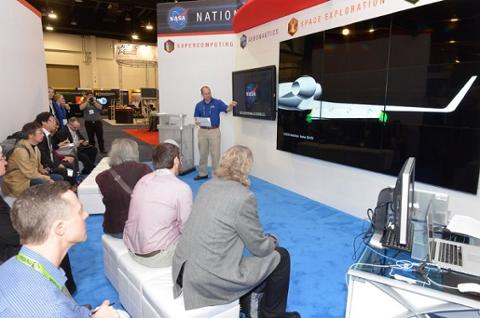 Research institutions, government agencies and other customers with deep pockets made 2012 a record year for high-performance computing (HPC) sales, as supercomputer revenues jumped 29.3 percent. The HPC market totaled $11.1 billion, a 7.7 percent increase versus 2011, research firm IDC said in a March 22 report. The actual numbers topped IDC's forecast of 7.1 percent growth. Total unit shipments dipped by 6.8 percent on a year-over-year basis, however—good news for HPC vendors, as this meant that the average price increased. IBM led all vendors, followed by Hewlett-Packard, although Dell and especially Fujitsu reported strong years. Fujitsu, helped by a $500 million sale of the K computer to Japan's RIKEN, saw a 470.5 percent increase in revenue. The HPC data should help offset what had been a lackluster year in the overall server market—although total server sales outperformed the HPC market by about $3 billion. Steve Conway, the IDC vice president responsible for technical computing, said that he didn't believe that the blistering pace would continue within the supercomputing segment, although IDC predicts a CAGR of 7.3 percent in the overall HPC market through 2015. IDC breaks out the HPC market into four price tiers: supercomputers, which sell for over $500,000; divisional machines, prices between $250,000 and $499,999; departmental machines, from $100,000 to $250,000; and the workgroup segment, with the lowest prices of all. Of the four tiers, the supercomputer segment represented 50.9 percent of all HPC revenue, and the segment grew 29.3 percent to $5.6 billion. Next up was the departmental segment, which dipped from $3.5 billion last year to $3.0 billion, but still made up 27 percent of all HPC revenue, topping the combined revenue of the divisional and workgroup segments, or 22.1 percent. IDC said that workgroup revenue dipped for two reasons: the global recession, as customers delayed purchases; and by consolidation, as workgroups pooled together and bought more powerful and expensive machines that could be centrally managed and shared. That's not necessarily a negative; in fact, IDC said that HPC machines continued to be seen as a necessary investment. "HPC technical servers, especially supercomputers, have been closely linked not only to scientific advances but also to industrial innovation and economic competitiveness," Earl Joseph, program vice president for technical computing at IDC, wrote in a statement. "For this reason, nations and regions across the world are increasing their investments in supercomputing even in today's challenging economic conditions." IBM captured 32.0 percent of all factory revenue, followed by HP, with a 30.8 percent share. Dell came in third with 13.5 percent. Cray revenue increased by a very strong 127.3 percent, driven by the acceptance of several large systems, IDC added. HPC systems can be used for everything from modeling climate change to improving the coefficient of drag from air moving over the surface of a car. Investing in supercomputers will undoubtedly continue. Image: Yentafern/Shutterstock.com
Research institutions, government agencies and other customers with deep pockets made 2012 a record year for high-performance computing (HPC) sales, as supercomputer revenues jumped 29.3 percent. The HPC market totaled $11.1 billion, a 7.7 percent increase versus 2011, research firm IDC said in a March 22 report. The actual numbers topped IDC's forecast of 7.1 percent growth. Total unit shipments dipped by 6.8 percent on a year-over-year basis, however—good news for HPC vendors, as this meant that the average price increased. IBM led all vendors, followed by Hewlett-Packard, although Dell and especially Fujitsu reported strong years. Fujitsu, helped by a $500 million sale of the K computer to Japan's RIKEN, saw a 470.5 percent increase in revenue. The HPC data should help offset what had been a lackluster year in the overall server market—although total server sales outperformed the HPC market by about $3 billion. Steve Conway, the IDC vice president responsible for technical computing, said that he didn't believe that the blistering pace would continue within the supercomputing segment, although IDC predicts a CAGR of 7.3 percent in the overall HPC market through 2015. IDC breaks out the HPC market into four price tiers: supercomputers, which sell for over $500,000; divisional machines, prices between $250,000 and $499,999; departmental machines, from $100,000 to $250,000; and the workgroup segment, with the lowest prices of all. Of the four tiers, the supercomputer segment represented 50.9 percent of all HPC revenue, and the segment grew 29.3 percent to $5.6 billion. Next up was the departmental segment, which dipped from $3.5 billion last year to $3.0 billion, but still made up 27 percent of all HPC revenue, topping the combined revenue of the divisional and workgroup segments, or 22.1 percent. IDC said that workgroup revenue dipped for two reasons: the global recession, as customers delayed purchases; and by consolidation, as workgroups pooled together and bought more powerful and expensive machines that could be centrally managed and shared. That's not necessarily a negative; in fact, IDC said that HPC machines continued to be seen as a necessary investment. "HPC technical servers, especially supercomputers, have been closely linked not only to scientific advances but also to industrial innovation and economic competitiveness," Earl Joseph, program vice president for technical computing at IDC, wrote in a statement. "For this reason, nations and regions across the world are increasing their investments in supercomputing even in today's challenging economic conditions." IBM captured 32.0 percent of all factory revenue, followed by HP, with a 30.8 percent share. Dell came in third with 13.5 percent. Cray revenue increased by a very strong 127.3 percent, driven by the acceptance of several large systems, IDC added. HPC systems can be used for everything from modeling climate change to improving the coefficient of drag from air moving over the surface of a car. Investing in supercomputers will undoubtedly continue. Image: Yentafern/Shutterstock.com HPC Sales Hit New Record in 2012
 Research institutions, government agencies and other customers with deep pockets made 2012 a record year for high-performance computing (HPC) sales, as supercomputer revenues jumped 29.3 percent. The HPC market totaled $11.1 billion, a 7.7 percent increase versus 2011, research firm IDC said in a March 22 report. The actual numbers topped IDC's forecast of 7.1 percent growth. Total unit shipments dipped by 6.8 percent on a year-over-year basis, however—good news for HPC vendors, as this meant that the average price increased. IBM led all vendors, followed by Hewlett-Packard, although Dell and especially Fujitsu reported strong years. Fujitsu, helped by a $500 million sale of the K computer to Japan's RIKEN, saw a 470.5 percent increase in revenue. The HPC data should help offset what had been a lackluster year in the overall server market—although total server sales outperformed the HPC market by about $3 billion. Steve Conway, the IDC vice president responsible for technical computing, said that he didn't believe that the blistering pace would continue within the supercomputing segment, although IDC predicts a CAGR of 7.3 percent in the overall HPC market through 2015. IDC breaks out the HPC market into four price tiers: supercomputers, which sell for over $500,000; divisional machines, prices between $250,000 and $499,999; departmental machines, from $100,000 to $250,000; and the workgroup segment, with the lowest prices of all. Of the four tiers, the supercomputer segment represented 50.9 percent of all HPC revenue, and the segment grew 29.3 percent to $5.6 billion. Next up was the departmental segment, which dipped from $3.5 billion last year to $3.0 billion, but still made up 27 percent of all HPC revenue, topping the combined revenue of the divisional and workgroup segments, or 22.1 percent. IDC said that workgroup revenue dipped for two reasons: the global recession, as customers delayed purchases; and by consolidation, as workgroups pooled together and bought more powerful and expensive machines that could be centrally managed and shared. That's not necessarily a negative; in fact, IDC said that HPC machines continued to be seen as a necessary investment. "HPC technical servers, especially supercomputers, have been closely linked not only to scientific advances but also to industrial innovation and economic competitiveness," Earl Joseph, program vice president for technical computing at IDC, wrote in a statement. "For this reason, nations and regions across the world are increasing their investments in supercomputing even in today's challenging economic conditions." IBM captured 32.0 percent of all factory revenue, followed by HP, with a 30.8 percent share. Dell came in third with 13.5 percent. Cray revenue increased by a very strong 127.3 percent, driven by the acceptance of several large systems, IDC added. HPC systems can be used for everything from modeling climate change to improving the coefficient of drag from air moving over the surface of a car. Investing in supercomputers will undoubtedly continue. Image: Yentafern/Shutterstock.com
Research institutions, government agencies and other customers with deep pockets made 2012 a record year for high-performance computing (HPC) sales, as supercomputer revenues jumped 29.3 percent. The HPC market totaled $11.1 billion, a 7.7 percent increase versus 2011, research firm IDC said in a March 22 report. The actual numbers topped IDC's forecast of 7.1 percent growth. Total unit shipments dipped by 6.8 percent on a year-over-year basis, however—good news for HPC vendors, as this meant that the average price increased. IBM led all vendors, followed by Hewlett-Packard, although Dell and especially Fujitsu reported strong years. Fujitsu, helped by a $500 million sale of the K computer to Japan's RIKEN, saw a 470.5 percent increase in revenue. The HPC data should help offset what had been a lackluster year in the overall server market—although total server sales outperformed the HPC market by about $3 billion. Steve Conway, the IDC vice president responsible for technical computing, said that he didn't believe that the blistering pace would continue within the supercomputing segment, although IDC predicts a CAGR of 7.3 percent in the overall HPC market through 2015. IDC breaks out the HPC market into four price tiers: supercomputers, which sell for over $500,000; divisional machines, prices between $250,000 and $499,999; departmental machines, from $100,000 to $250,000; and the workgroup segment, with the lowest prices of all. Of the four tiers, the supercomputer segment represented 50.9 percent of all HPC revenue, and the segment grew 29.3 percent to $5.6 billion. Next up was the departmental segment, which dipped from $3.5 billion last year to $3.0 billion, but still made up 27 percent of all HPC revenue, topping the combined revenue of the divisional and workgroup segments, or 22.1 percent. IDC said that workgroup revenue dipped for two reasons: the global recession, as customers delayed purchases; and by consolidation, as workgroups pooled together and bought more powerful and expensive machines that could be centrally managed and shared. That's not necessarily a negative; in fact, IDC said that HPC machines continued to be seen as a necessary investment. "HPC technical servers, especially supercomputers, have been closely linked not only to scientific advances but also to industrial innovation and economic competitiveness," Earl Joseph, program vice president for technical computing at IDC, wrote in a statement. "For this reason, nations and regions across the world are increasing their investments in supercomputing even in today's challenging economic conditions." IBM captured 32.0 percent of all factory revenue, followed by HP, with a 30.8 percent share. Dell came in third with 13.5 percent. Cray revenue increased by a very strong 127.3 percent, driven by the acceptance of several large systems, IDC added. HPC systems can be used for everything from modeling climate change to improving the coefficient of drag from air moving over the surface of a car. Investing in supercomputers will undoubtedly continue. Image: Yentafern/Shutterstock.com 
